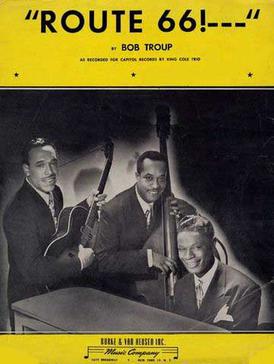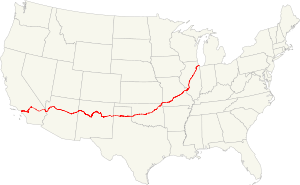(Get Your Kicks on) Route 66 facts for kids
Quick facts for kids "(Get Your Kicks on) Route 66" |
|
|---|---|

Sheet music cover featuring the King Cole Trio
|
|
| Single by the King Cole Trio | |
| B-side | "Everyone Is Sayin' Hello Again (Why Must We Say Goodbye)" |
| Released | April 22, 1946 |
| Recorded | 1946 |
| Studio | Radio Recorders, Los Angeles, California |
| Genre | Rhythm and blues |
| Length | 2:57 |
| Label | Capitol |
| Songwriter(s) | Bobby Troup |
The song "(Get Your Kicks on) Route 66" is a very popular rhythm and blues song. It was written in 1946 by an American songwriter named Bobby Troup. The words of the song describe a trip along U.S. Route 66 (US 66). This famous road went across the western part of the U.S. It started in Chicago, Illinois, and ended in Los Angeles, California. The song became a classic, and many different artists have recorded it.
Contents
How the Song Was Created
Bobby Troup got the idea for the song during a long car trip. He was driving across the country from Pennsylvania to California. Bobby wanted to become a songwriter in Hollywood. So, he and his wife, Cynthia, packed their 1941 Buick and drove west.
Their journey started on US 40. Then, they continued along US 66 all the way to the California coast. Bobby first thought about writing a song about US 40. But Cynthia suggested the title "Get Your Kicks on Route 66". Bobby wrote the song during their ten-day trip. He finished it by looking at maps once they arrived in Los Angeles.
What the Lyrics Say
The lyrics of the song are like a mini-travel guide. They list many major cities and towns along Route 66. These include St. Louis; Joplin, Missouri; Oklahoma City, Oklahoma; Amarillo, Texas; Gallup, New Mexico; Flagstaff, Arizona; Winona, Arizona; Kingman, Arizona; Barstow, California; and San Bernardino, California.
Winona is the only town mentioned out of order. It was a very small place east of Flagstaff. It might have been forgotten if not for the line "Don't forget Winona". This line was written to rhyme with "Flagstaff, Arizona". Many artists who have sung this song have changed the first few lines. They often sing "It goes to St. Louis, down through Missouri..." The actual Route 66 passes through eight states. However, the song does not mention Kansas. Route 66 only goes about 11 miles (18 km) through the southeast corner of Kansas.
Nat King Cole's Original Recording
Nat King Cole and his group, the King Cole Trio, were the first to record this song. They recorded it in 1946 at Radio Recorders in Los Angeles. Capitol Records released it as a single song. It quickly became a hit. The song reached number three on Billboard magazine's Race Records chart. It also reached number eleven on their main singles chart. Nat King Cole recorded the song again later in 1956 and 1961.
Other Famous Versions
This song has become a classic, and many artists have recorded their own versions.
- Bing Crosby and the Andrews Sisters recorded a version in 1946. It reached number 14 on the Billboard chart.
- In 1964, the Rolling Stones included their version on their first album. A music critic named Richie Unterberger called it "the most famous rock version of the song." He said it was one of the best songs on their first album. It was also very popular in their early concerts. The group learned this song from a version that Chuck Berry recorded in 1961.
- Billy Bragg recorded a British version of the song in 1985. He called it "A13 (Trunk Road to the Sea)". He used the same music but changed the city names to English towns along the A13 road. He invited listeners to "Go motoring, on the A-thirteen". Billy Bragg said he wrote the lyrics in 1977. He felt strange singing about places he didn't know in America. The A13 road led to Southend, which was a special place for him growing up.
- Michael Martin Murphey recorded the song for his 1989 album. His version was released as a single in 1990. It reached number 67 on the Billboard Hot Country Singles & Tracks chart.
- The 2006 Pixar animated movie Cars features versions by Chuck Berry and John Mayer. John Mayer's version was even nominated for a Grammy award.
See also
 In Spanish: Route 66 (canción) para niños
In Spanish: Route 66 (canción) para niños


